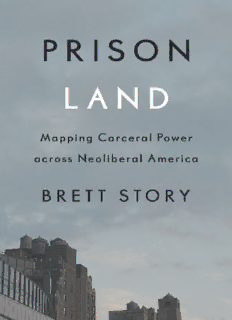
Prison Land: Mapping Carceral Power across Neoliberal America PDF
Preview Prison Land: Mapping Carceral Power across Neoliberal America
Prison Land This page intentionally left blank Prison Land Mapping Carceral Power across Neoliberal America Brett Story University of Minnesota Press Minneapolis | London The University of Minnesota Press gratefully acknowledges the generous assistance provided for the publication of this book by the Margaret S. Harding Memorial Endowment, honoring the first director of the University of Minnesota Press. Portions of chapters 1 and 2 were published in “The Prison and the City: Tracking the Neoliberal Life of the ‘Million Dollar Block,’” Theoretical Criminology 20, no. 3 (2016): 257– 76. Portions of chapter 1 were published in “Against a Humanizing Prison Cinema: The Prison in Twelve Landscapes and the Politics of Abolition Imagery,” in The Visual Criminology Handbook, ed. M. Brown and E. Carrabine, 455– 66 (London: Routledge, 2017). Portions of chapter 3 were published in B. Story and J. Schept, “Against Punishment: Centering Work, Wage, and Uneven Development in Mapping the Carceral State,” Social Justice: A Journal of Crime, Conflict, and World Order 46 (forthcoming in 2019). Copyright 2019 by the Regents of the University of Minnesota All rights reserved. No part of this publication may be reproduced, stored in a retrieval system, or transmitted in any form or by any means, electronic, mechanical, photocopying, recording, or otherwise, without the prior written permission of the publisher. Published by the University of Minnesota Press 111 Third Avenue South, Suite 290 Minneapolis, MN 55401- 2520 upress.umn.edu Printed in the United States of America on acid- free paper The University of Minnesota is an equal- opportunity educator and employer. 26 25 24 23 22 21 20 19 10 9 8 7 6 5 4 3 2 1 Library of Congress Cataloging-in-Publication Data Names: Story, Brett, author. Title: Prison land : mapping carceral power across neoliberal America / Brett Story. Description: Minneapolis : University of Minnesota Press, 2019. | Includes bibliographical references and index. | Identifiers: LCCN 2018045509 (print) | ISBN 978-1-5179-0687-0 (hc) | ISBN 978-1-5179-0688-7 (pb) Subjects: LCSH: Prisons—United States. | Prisons—Canada. | Discrimination in criminal justice administration—United States. | Discrimination in criminal justice administration—Canada. | Corrections—Political aspects—United States. | Corrections— Political aspects—Canada. | Capitalism—United States. | Capitalism—Canada. | BISAC: SOCIAL SCIENCE / Penology. | SOCIAL SCIENCE / Human Geography. | SOCIAL SCIENCE / Anthropology / Cultural. Classification: LCC HV9471 .S843 2019 (print) | DDC 365/.973—dc23 LC record available at https://lccn.loc.gov/2018045509 For birdie This page intentionally left blank Contents Preface ix Introduction The Prison out of Place 1 1 The Prison in the City: Securitizing Property 29 in Bankrupt Detroit 2 N eighborhood Watch: Reform and Real Estate 51 in Gentrifying Brooklyn 3 Rural Extractions: Work and Wages 79 in the Appalachian Coalfields 4 The Prison In- Between: Caretaking and Crisis 105 on the Visitors’ Bus 5 Community Confinements: Social Control in Everyday Life 137 Conclusion Freedom Struggles and the Future 167 of Carceral Space Acknowledgments 185 Notes 189 Bibliography 193 Index 213 This page intentionally left blank Preface I came to the prison, at first, indirectly. Not through arrest or conviction at all, but through eviction. The first time I was evicted, it was the mid- 1980s and I was a child living in Toronto with my mother, a single parent on social assistance. We shared a bedroom in a house with a group of other, mostly low income, women. The real estate market in our neigh- borhood had just begun heating up, and the collective rent paid by the tenants in our house didn’t match what other apartments in the neighbor- hood were starting to rent for. So our landlord took advantage of a loop- hole in the municipal rent-c ontrol rules to evict all of us. Modest single- family homes in that same neighborhood now sell for millions of dollars. Almost twenty years later, I found myself facing eviction again, under similar circumstances, though as a student rather than as a child. I’d moved to Montreal in the late 1990s, just as its independent music scene was exploding and the hangover of Quebec separatism still guaranteed cheap rents for working people, artists, and activists. The province’s flight risk (manifested as late as 1995 in a province- wide referendum on independence from Canada) made the terrain too unstable for real- estate capital, which was good news for everyone I knew. It meant we could work part- time jobs and spend our real time doing political organizing, making art, and building community. But that eventually started to change, and the real estate developers descended. When my landlord evicted my roommates and me in a legally suspect move with echoes of the eviction I’d faced as child, I decided to make a film about gentrifica- tion and its consequences. ix
Description: